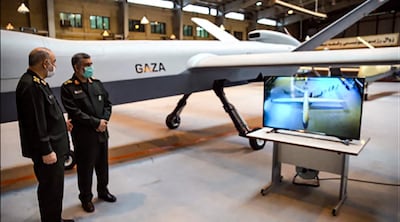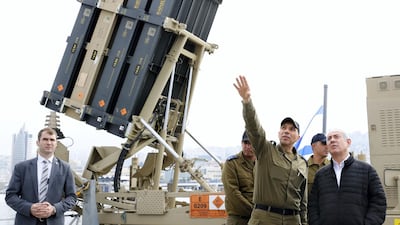Israel's vaunted Iron Dome defence system was severely tested by a battery of drones designed and supplied by Iran, experts told The National.
During the recent conflict, Tehran supplied Hamas with equipment and technology for the extremists to set up their own defence manufacturing industry to launch attacks from Gaza.
The threat from the barrages during the 11-day war led Israel to deploy its missile interceptors on the back of frigates patrolling the Mediterranean coast to defend gas installations and the mainland.
While Israel's forces managed to shoot down at least six of the kamikaze drones launched from Gaza, it is understood that Iran will assess the attack methods to improve them for future conflict.
“Hamas has clearly had external support from Iran and that interest will remain,” said Douglas Barrie, of the International Institute for Strategic Studies think tank.
“If there’s one country who's going to be interested in how this all went and how Hamas’s weapons might be improved in the future, then you would look at Iran.”
It is apparent that operatives from the Islamic Revolutionary Guard Corps managed to smuggle components of their Ababil-2 unmanned aerial vehicle and taught Hamas to equip it with a warhead.
The drone, which Hamas called the Shehab, carries a 30 kilogram warhead and can cruise at 250kph. It is programmed with GPS co-ordinates and satellite imagery to find its target. Alternatively, it can be guided visually to the target with a ground operator and camera.
“With Iran’s help, Hamas has developed quite a large number of not terribly expensive munitions, which can be sent to hit fixed targets at long range,” said Justin Bronk, of the Royal United Services Institute think tank in London.
“The Iranians will have given them some initial examples, as well as training manuals on how to construct them. Once you've transferred that expertise, because they are relatively low-tech, Hamas has become pretty proficient at manufacturing their own in Gaza.”
He said the key components smuggled from Iran would have included GPS tracking chips, stabilisation gyroscopes and engine parts.
In addition to the estimated 4,000 missiles fired from Gaza that put the Iron Dome system under pressure to protect Israel, Hamas launched several Shehab drones during the conflict.
At least one was shot down by an air-to-air missile fired from an F16 fighter, another intercepted by Iron Dome, while four were downed by what the Israelis called “classified means”. Israel also shot down an actual Iranian drone near the border with Jordan on Tuesday.

Israel had to rapidly readjust its defences to pick up the threat of low-flying UAVs, which have a low radar signature, while it was using its system to intercept Hamas missiles, putting the system under considerable strain.
Experts believe that if Hezbollah had become involved and used its satellite-guided missiles developed by Iran, the Iron Dome could have been overwhelmed.
The Israelis are now “putting a lot of money” into developing lasers and other high-powered microwave weaponry to shoot down drones, Mr Barrie said.
Hamas’s evolution into developing attack drones bears close similarity to the Houthis in Yemen targeting Saudi Arabia, defence analysts believe.
"This is part of the Iranian programme where it's all about helping allied groups to produce their own weaponry from readily available resources so that reduces supplying them directly with weapons," said Jeremy Binnie, a missile expert at Jane's Defence Weekly. "It makes the situation a bit more deniable for Tehran."
Mr Binnie agreed that the Shehab drone was “broadly similar” to the Iranian Ababil-2, which the Houthis call the Qasef and produce using the Iranian design and components. “Hamas is likely doing the same thing as the Houthis because the IRGC has a policy of developing self-sufficiency in the groups it supports.”
While Israel’s defence system appears to have prevented the UAVs causing major casualties, Mr Barrie said it may be only a matter of time before a kamikaze drone gets through. “It’s a bit like the old IRA (Irish Republican Army) saying that ‘you've got to be lucky every day, we've only got to get lucky once’,” he said.


